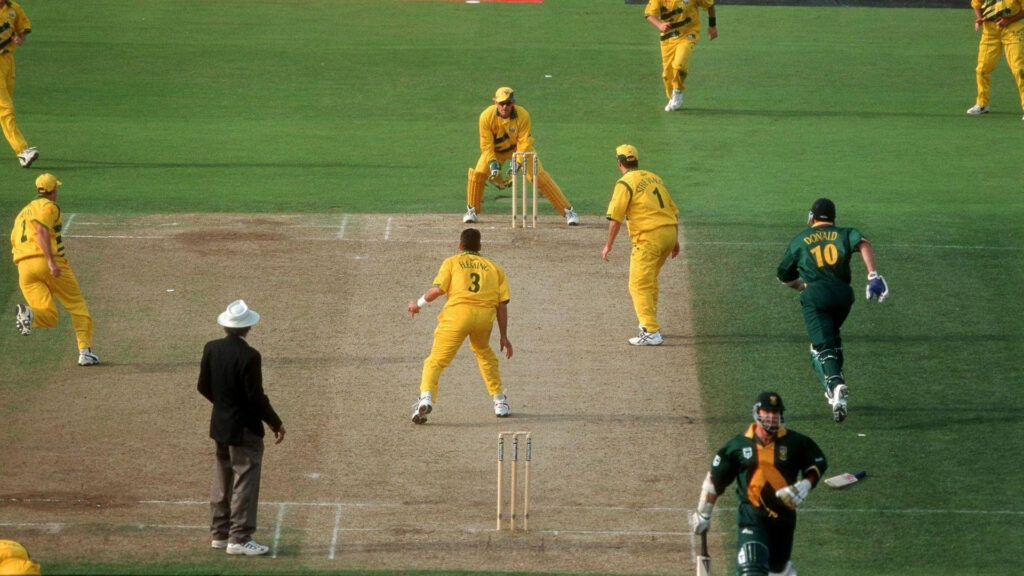Do you remember the famous 1999 world cup semi final between Australia and South Africa.
As there was no super over format at that time, It was the Net Run Rate rule that allowed Australia to advance into the final

What is Net Run Rate ? How it is calculated
In this post we will learn how NRR is calculated in different scenario.
Table of Contents
What is Net Run Rate
Net Run Rate which also abbreviated as NRR, It is a statistical tool used to measure the performance of a team in limited over ( Odi, T20, T10) matches.
Why NRR is important
NRR mainly used for tie breaker in the tournaments. If two team has same points and 1 team have to advance, NRR is used to tie break. The team which have higher NRR will advance to next round. Please note that each tournament have each set of rules for advancing in to the next round.

How Net Run Rate is calculated
Net run Rate calculation is simple. But inaccurate data will lead to misleading results
Formula of NRR Calculation
\[ \text{NRR} = \frac{\text{Runs Scored}}{\text{Overs Faced}} – \frac{\text{Runs Conceded}}{\text{Overs Bowled}} \]
Where:
- \( \text{Runs Scored} \) – The total runs scored by the team
- \( \text{Overs Faced} \) – The total number of overs faced by the team while batting.
- \( \text{Runs Conceded} \) – The total runs scored by the opponents against the team.
- \( \text{Overs Bowled} \) – The total number of balls bowled by the team while fielding.
Now we can go to the various NRR Scenarios
Starting with some basic calculations
Case 1 – In a tournament, Team India scored 1100 runs in 120 overs and conceded 1048 runs in 130 overs. What is the net run rate of India
We can apply the NRR calculation formula
- Runs Scored – 1100
- Overs Faced – 120
- Runs Conceded – 1048
- Overs Bowled – 130
\[ \text{NRR} = \frac{\text{1100}}{\text{120}} – \frac{\text{1048}}{\text{130}} \]
NRR of India is +1.105
Team India having positive NRR. It suggests that team India scored more runs than what opposition scored against them. This also implies, team India’s dominant performance in the tournament
Dealing With Decimals
Each over consists of six balls. So, when converting overs into decimal form for NRR calculations, you should express any remaining balls as a mathematically equivalent
An over contain 6 balls. if an over showing 20.2, it means the team bowled 20 overs and 2 balls. so total (20*6)+ 2 = 122 Balls.
There will be instance when the team not completely play the whole over. so we have to deal with decimals
Case 2 : Team Australia score 620 runs in 58.3 overs. In bowling they conceded 580 runs in 60.2 overs. What is the net run rate of Australia ?
In scoring the Australia faced 58.3 overs. This is in Over decimal form. 0.3 means they have only played the 3 balls in an over that’s why it showing .3 in the over. We have to convert into the mathematically equivalent.
.3 means they played half of an over. In this NRR Calculation, Over faced will be 58 and half of an over. So we have to change 58.3 to 58.5
Australia bowled 60.2 overs. We have to change the decimal. 2 balls means 2/6 of an over. So the overs will be 60+2/6 = 60.333
\[ \text{NRR} = \frac{\text{620}}{\text{58.5}} – \frac{\text{580}}{\text{60.333}} \]
After Calculating we will get NRR = 0.984
| Balls | Decimal to put |
| 1 | 0.166 |
| 2 | 0.333 |
| 3 | 0.500 |
| 4 | 0.666 |
| 5 | 0.833 |
Scenarios when team All out before the full over
Case 3 : In an odi match between New Zealand and England, New Zealand all out for 210 runs in 41.4 overs. England scored 211 runs in 45.5 overs. What is the NRR of New Zealand
When a team all out it is considered as they have faced all the overs.
we can calculate the NRR of New Zealand
- Runs scored – 210
- Overs faced – 50 (New Zealand all out)
- Runs conceeded – 211
- Overs Bowled – 45.5
\[ \text{NRR} = \frac{\text{210}}{\text{50}} – \frac{\text{211}}{\text{45.833}} \]
If you got NRR = -0.403, That is correct
These are the various cases in NRR Calculation
Hope Everyone understand Net Run Rate. you can leave doubts and feedback below
Check out our NRR Calculator
